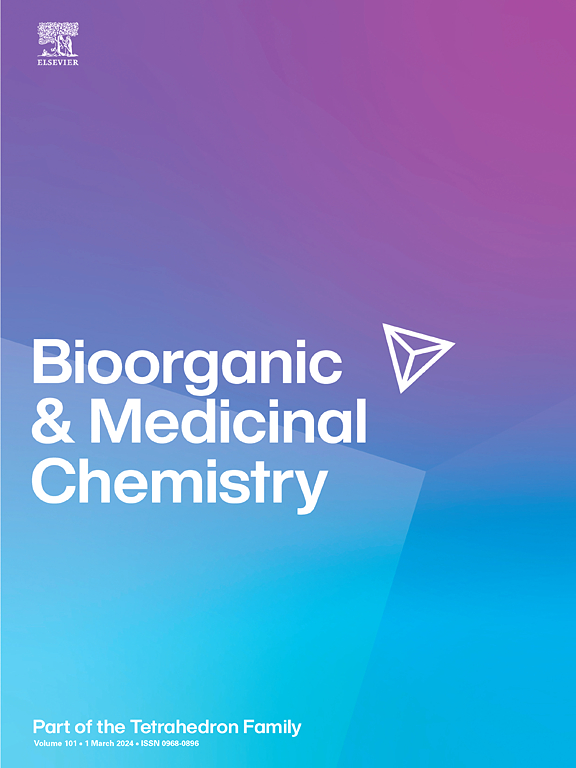Synthesis of 2-(3-aminopropyl)benzopyrans as potential antipsychotic agents targeting D2/D3 and 5-HT2A receptors
IF 3
3区 医学
Q2 BIOCHEMISTRY & MOLECULAR BIOLOGY
引用次数: 0
Abstract
The high prevalence and complexity of neurological and psychiatric disorders, such as schizophrenia, makes the development of new, safer and more effective neuroleptic drugs a continuing need. We have synthesized 2-(3-aminopropyl)benzopyrans bearing a chroman-6-ol nucleus, a 3‑carbon atoms side chain, and an ionisable nitrogen into different amine frameworks. The specific affinity of 2-(3-aminopropyl)benzopyrans was determined by competition binding assays of radioligands on membranes from CHO cells stably expressing the cloned human D2, D3 and 5-HT2A receptors. Results showed that benzopyrans 9b, 9e, 9f and 11, all of them with a free phenol group in the chromanol nucleus, displaced the specific radioligand for hD2 and hD3 in the submicromolar or low micromolar range. Molecular docking analysis shows that the nitrogen atom of amine substituents plays a key role to bind the orthosteric binding site of both D2R and 5-HT2AR, as well as the oxygen atom of phenol group for binding to the D2R. In addition, functional assays revealed a partial hD2 agonism and h5-HT2A antagonism for 9b, 9e and 11 derivatives as new atypical antipsychotic agents, while compound 9f behaved as a D2 antagonist like a first-generation neuroleptic.

2-(3-氨基丙基)苯并吡喃作为D2/D3和5-HT2A受体潜在抗精神病药物的合成
精神分裂症等神经和精神疾病的高患病率和复杂性使得开发新的、更安全、更有效的抗精神病药物成为一项持续的需求。我们已经合成了2-(3-氨基丙基)苯并吡喃,它具有一个铬-6-醇核,一个3-碳原子侧链和一个可电离氮到不同的胺框架中。2-(3-氨基丙基)苯并吡喃类药物的特异性亲和力是通过竞争结合实验确定的,该实验是通过稳定表达克隆的人D2、D3和5-HT2A受体的CHO细胞膜上的放射性配体来确定的。结果表明,苯并吡喃9b、9e、9f和11在铬酚核中均含有游离酚基团,在亚微摩尔或低微摩尔范围内取代了hD2和hD3的特定放射配体。分子对接分析表明,胺取代基的氮原子对D2R和5-HT2AR的正构结合位点以及苯酚基的氧原子对D2R的结合起着关键作用。此外,功能分析显示9b、9e和11个衍生物作为新的非典型抗精神病药物具有部分hD2激动作用和h5-HT2A拮抗剂,而化合物9f作为D2拮抗剂的作用类似于第一代抗精神病药。
本文章由计算机程序翻译,如有差异,请以英文原文为准。
求助全文
约1分钟内获得全文
求助全文
来源期刊

Bioorganic & Medicinal Chemistry
医学-生化与分子生物学
CiteScore
6.80
自引率
2.90%
发文量
413
审稿时长
17 days
期刊介绍:
Bioorganic & Medicinal Chemistry provides an international forum for the publication of full original research papers and critical reviews on molecular interactions in key biological targets such as receptors, channels, enzymes, nucleotides, lipids and saccharides.
The aim of the journal is to promote a better understanding at the molecular level of life processes, and living organisms, as well as the interaction of these with chemical agents. A special feature will be that colour illustrations will be reproduced at no charge to the author, provided that the Editor agrees that colour is essential to the information content of the illustration in question.
 求助内容:
求助内容: 应助结果提醒方式:
应助结果提醒方式:


